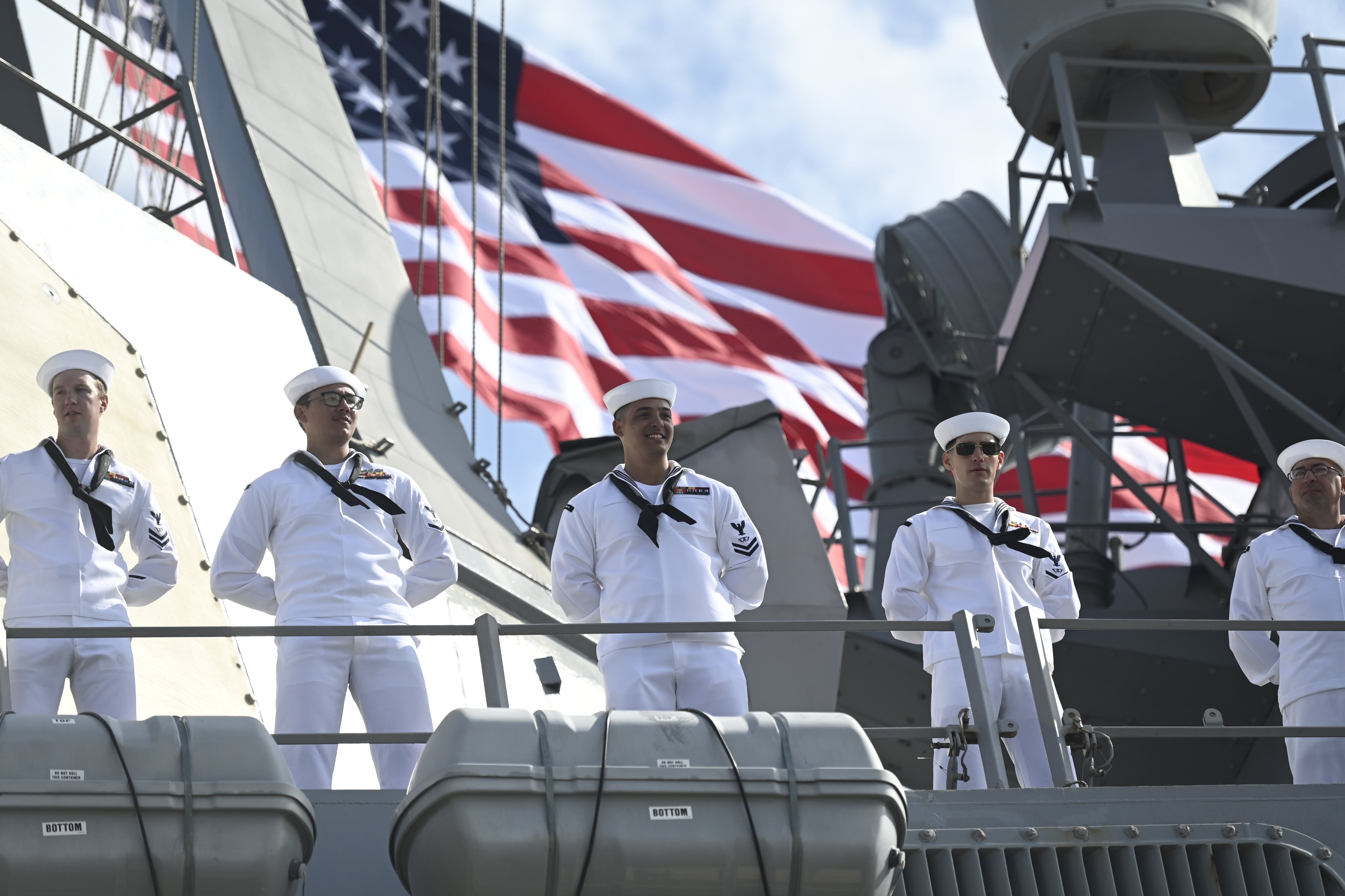The women and men aboard the Navy destroyer Carney could possibly be forgiven for considering they had been headed towards a quiet cruise on Oct. 7, 2023, because the warship steamed east throughout the Atlantic Ocean to start its newest deployment.
However that day heralded the beginning of an amazing upending for the U.S. Navy, after Hamas militants streamed into Israel and murdered greater than 1,200 folks, sparking a warfare that continues to threaten to engulf the Center East to today.
The second that may change the Navy perpetually really befell aboard the Carney 12 days later, on Oct. 19, when it grew to become the primary American warship to take out a barrage of Iran-backed Houthi insurgent missiles and drones fired from Yemen.
Such intercepts have since change into a harrowing, near-daily prevalence for destroyers in these waters, and the yr that adopted Oct. 19, 2023, has irrevocably modified the Navy for the foreseeable future, Navy leaders and out of doors analysts say.
On today one yr in the past, beginning round 4 p.m. native time, Carney took out a Houthi assault the Pentagon later stated was headed for Israel, downing 15 drones and 4 land-attack cruise missiles over 10 hours.
Whereas their pre-deployment coaching ready them for something, the Carney was not anticipating to search out itself taking up the Houthis in a near-daily battle to maintain the claustrophobic Pink Sea lanes open for commerce, Cmdr. Jeremy Robertson, the ship’s commanding officer for that cruise, informed Navy Occasions this week.
“None of us actually might have identified what we had been going to get into as soon as Oct. 7 occurred,” he stated.

Since these fateful 10 hours a yr in the past, the Pink Sea has change into the sector for the longest sustained “direct and deliberate assaults at sea” that the fleet has confronted since World Struggle II, Fleet Forces Command head Adm. Daryl Caudle stated in an announcement to Navy Occasions.
“Whereas I couldn’t have predicted the complexity and interrelationships of all that has transpired since [Oct. 19, 2023], I’m not shocked,” stated Caudle, who instructions the Navy East Coast-based fleet.

“The world is a really tense place proper now given the huge vary of power-seeking agendas between peer opponents and opportunistic regional proxies. Any small spark can have severe penalties, which is why we take each state of affairs so critically.”
Since Carney’s first victory, the floor fleet has subsequently honed its techniques and tuned its radars for such a combat, situations when a ship’s Fight Data Middle typically has mere seconds to establish and take out a Houthi assault.
Fight classes are being routed again to schoolhouses and coaching facilities, giving the Navy real-time information on its fight techniques and how you can finest use them.
Skippers additionally report that their crews have been galvanized by such experiences, discovering that means to their seemingly infinite coaching within the life-and-death minutes they endure within the Pink Sea and Gulf of Aden.
“This actually gave our sailors the why,” Robertson stated. “Why will we practice so arduous, why will we do all of the reps and units.”
“The stage was not too large, the lights weren’t too brilliant. They had been ready to attract a connection.”
These successes at sea “validate our readiness to reply, our Sailors’ warfighting spirit and the technological superiority of our beautiful fight techniques,” Caudle stated.

However regardless of the tactical successes and demonstrated proficiencies, some query how briskly the Navy is burning by munitions, typically to take out low cost Houthi drones, and whether or not a drawdown of missiles might someday influence a long-feared warfare with China within the West Pacific.
The Houthi menace within the Center East has additionally triggered the Navy’s plane carriers to be run arduous, and a few have been scrambled to the area when others weren’t able to go, additional elevating readiness alarms in some corners.
And whereas tactical battles have been gained, strategic wars haven’t, in keeping with James Holmes, a retired Navy gunnery officer and professor of maritime technique on the Naval Struggle School.
“The tacticians have achieved their work magnificently … and the mix of sensors, fireplace management and weaponry has carried out as marketed towards an array of threats just like what [Iran, Russia and China] area,” Holmes informed Navy Occasions. “Bringing down anti-ship ballistic and cruise missiles isn’t any straightforward feat, however they’ve achieved it.”

And whereas such successes will reverberate on different maritime battlefields, the Navy thus far has been unable to cease the Houthis from attacking service provider vessels touring by the very important financial waterway that’s the Pink Sea, he stated.
“The failure half is that the mission has fallen in need of its strategic purpose, particularly permitting service provider delivery by the Gulf of Aden, Bab el-Mandeb Strait, and Pink Sea to renew unmolested,” Holmes stated. “We are able to flip strategic failure to success when delivery corporations — and the all-important maritime insurance coverage corporations — really feel comfy sufficient to start out utilizing that route once more.”
A yr in, the Navy is getting extra even handed about the way it fights Houthi assaults, in keeping with Bryan Clark, a retired submarine officer and analyst on the Hudson Institute assume tank.
Navy ships threw the “kitchen sink” at incoming drones and missiles after the Carney’s first intercept a yr in the past, however the fleet is changing into more proficient at utilizing digital warfare, weapons and less-expensive interceptors to counter such Houthi assaults, Clark stated.
Questions of sustainability of effort at the moment are arising, he stated, noting that the Navy has in some situations used carrier-based fighter jets to shoot down Houthi drones and missiles, an costly and inefficient strategy.
“The problem going ahead might be how you can maintain this degree of presence within the area,” Clark stated. “The Pentagon might have to contemplate placing missile protection techniques on barges or ashore so [destroyers] can deploy elsewhere or return house for upkeep.”
Robertson left the Carney after it returned to Mayport, Florida, in Might, and is now the Navy’s Floor Warfare Superior Tactical Coaching, or SWATT, director, passing on his hard-earned information.

“It’s actually surreal,” he stated of his time commanding Carney. “I really like each one of many sailors and officers and chiefs I labored with. Only a nice crew. They’ll bear in mind this for the remainder of their lives.”
Because the one-year anniversary of Oct. 19 comes and goes ad infinitum for the Navy’s Pink Sea combat towards the Houthis, Caudle famous that it’s troublesome to forecast how the battle will finish.
“Whereas I gained’t speculate on how our involvement with the Houthis will culminate, I can let you know that I’m laser-focused on readiness, sustainment and lethality,” he stated. “We’re prepared for this combat, not matter how lengthy it lasts.”
Geoff is the managing editor of Army Occasions, however he nonetheless loves writing tales. He lined Iraq and Afghanistan extensively and was a reporter on the Chicago Tribune. He welcomes any and every kind of ideas at geoffz@militarytimes.com.






















